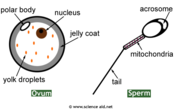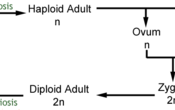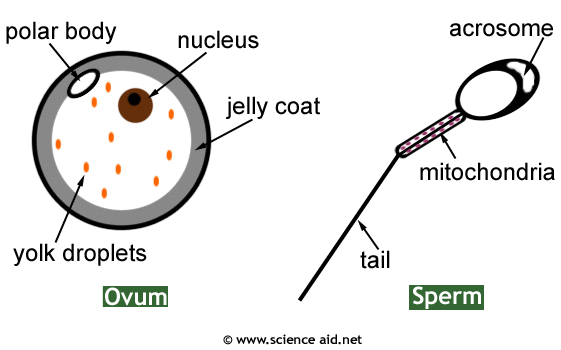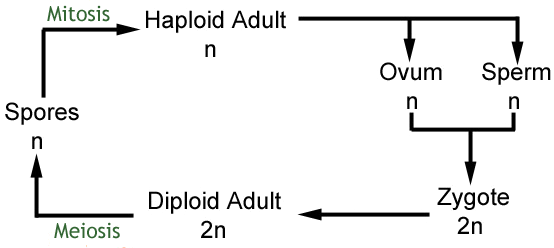Sexual Redroduction: Sperm and Ova structures, meiosis and life cycles
Edited by Jamie (ScienceAid Editor), Taylor (ScienceAid Editor), SmartyPants, Doug Collins
Sexual reproduction is a way of producing offspring where the DNA of two parents mix to make a genetically different offspring (this is what mammals do). This is opposite to asexual reproduction where clones are made, like with bacteria.
Gametes
A gamete is the scientific term for sex cells that contain the DNA that is going to be passed on to the offspring. Males and females have different gametes, and here we will look at the human sperm and ovum.
- 1Some key parts of the ovum are the yolk droplets in the cytoplasm that provide energy to the developing fetus until it connects to the mother by the umbilical chord. And the polar body is the other half of the ovum produced because it doesn't divide evenly.OVUM.Advertisement
- 2Key parts of the sperm cell include: acrosome that contains enzymes that break down the jelly coat so it can enter. And the middle piece contains a lot of mitochondria that provide energy for their tail to flick about to move it.SPERM.
Now we've looked at differences in the structures, we'll look at some other key differences.
| Ovum | Sperm | |
| Size | Over 100μm in diameter. | About 25μm long |
| Number produced | Relatively few and aren't replenished. | Trillions produced in a lifetime, and 400 million per ejaculate, constantly being developed. |
| Mobility | The ovum gets moved along the Fallopian tube by cillia. | The sperm move themselves with their tail. |
Meiosis
For more about meioisis see: Variation and Meiosis.
We won't go into too much detail about this process. But it's similar to [biology/cell/cycle.html|mitosis], in that it goes from a diploid cell to a haploid by dividing so that a cell with pairs of homologous chromosomes divides. Each new cell has one chromosome from each homologous pair. Meiosis is important because it produces haploid gametes so when the two fuse, the resulting zygote has got a diploid number of chromosomes. This is maintained from generation to generation.
Life Cycle
A life cycle shows how haploid (n) and diploid (2n) vary over time.
The life cycle of the above organism may seem a bit odd, but the only rules you need to remember are that meiosis halves the chromosome number but mitosis maintains it. And that fertilization doubles the number; and you should have no problem.
Referencing this Article
If you need to reference this article in your work, you can copy-paste the following depending on your required format:
APA (American Psychological Association)
Sexual Redroduction: Sperm and Ova structures, meiosis and life cycles. (2017). In ScienceAid. Retrieved Apr 17, 2024, from https://scienceaid.net/biology/genetics/reproduction.html
MLA (Modern Language Association) "Sexual Redroduction: Sperm and Ova structures, meiosis and life cycles." ScienceAid, scienceaid.net/biology/genetics/reproduction.html Accessed 17 Apr 2024.
Chicago / Turabian ScienceAid.net. "Sexual Redroduction: Sperm and Ova structures, meiosis and life cycles." Accessed Apr 17, 2024. https://scienceaid.net/biology/genetics/reproduction.html.
If you have problems with any of the steps in this article, please ask a question for more help, or post in the comments section below.
Comments
Article Info
Categories : Genetics
Recent edits by: SmartyPants, Taylor (ScienceAid Editor), Jamie (ScienceAid Editor)










